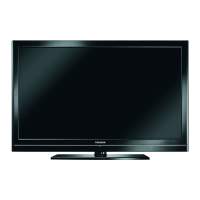
Do you have a question about the Toshiba 40BV701B and is the answer not in the manual?
| Screen Size | 40 inches |
|---|---|
| Resolution | 1920 x 1080 |
| Display Type | LCD |
| USB Ports | 2 |
| Audio Output | 20W |
| Backlight | LED |
| Refresh Rate | 50 Hz |
| Built-in Wi-Fi | No |
| Smart TV | No |
| Energy Efficiency Class | A |
Provides an overview of the user manual's purpose and scope.
Directs users to the website for advanced TV functions.
Explains how the digital switchover affects TV equipment and required user actions.
Guides users on the process of re-tuning their TV during the digital switchover.
Step-by-step instructions for carrying out an automatic channel scan for TOSHIBA Freeview products.
Instructions for manually re-tuning channels when automatic methods are insufficient or for specific needs.
Covers air circulation, heat damage, mains supply, and general do's and don'ts.
Guidelines for TV placement, wall mounting, and cleaning to ensure safety.
Details headphone warnings, LCD screen care, TV installation hazards, and operational safety.
Steps for wall mounting the LCD TV, including bracket selection and attachment.
Detailed instructions on how to safely remove the TV's pedestal stand.
Identifies buttons and functions of the remote control for TV operation.
Guidance on inserting batteries and understanding the remote's effective operating range.
Instructions for connecting aerial cables and SCART leads to the TV.
Details various connection ports like HDMI, YPbPr, and audio inputs.
Steps for connecting HDMI sources, including cable type recommendations.
Instructions for connecting DVI sources, requiring an adapter and audio cables.
How to connect a computer via VGA or HDMI for display on the TV.
Guides on connecting USB drives for media playback and precautions.
How to use Power Save Mode for energy efficiency and environmental benefits.
Information on the product's lifespan and end-of-life recycling procedures.
Instructions for powering the TV on, off, and entering standby mode.
Guidance on operating the TV using both the remote control and physical buttons.
A comprehensive guide to the initial installation, including language and country selection.
Explanation of the auto-tuning process for receiving broadcast channels.
Procedures for manually searching for digital and analogue TV channels.
Method for fine-tuning analogue channels to improve reception quality.
Controlling stereo/bilingual audio and displaying subtitles for broadcasts.
Guidance on using the main menu, volume control, and channel selection.
How to view, move, delete, rename, and lock channels.
Steps to lock specific channels using a PIN for parental control.
Displays information about the current channel and program.
Provides access to TV schedules and program details.
Customizing preferred languages for menus, audio, subtitles, and teletext.
Managing parental ratings, menu access locks, and setting a PIN.
Using maturity lock and child lock features for content control.
Adjusting contrast, brightness, sharpness, colour, backlight, and noise reduction.
Selecting picture modes and enabling power saving features for energy efficiency.
Customizing colour temperature and picture zoom levels for enhanced viewing.
Adjusting colour tones and resetting picture settings to default values.
Choosing different aspect ratios (16:9, 4:3, Zoom, etc.) for optimal viewing.
Fine-tuning PC display settings like H/V Position, Dot Clock, and Phase for clarity.
Adjusting volume, equalizer, balance, and headphone settings.
Utilizing AVL, Dynamic Bass, and Surround Sound for improved audio output.
Overview of the settings menu for personalizing TV preferences.
Instructions for inserting and managing Conditional Access Modules for subscription services.
Setting timers for specific programmes or automatic TV shut-off.
Adjusting the TV's date, time, and time zone for accurate operation.
Enabling/disabling input sources and switching between them.
Adjusting menu timeout, scan encrypted channels, and other general preferences.
Configuring blue background, audio description, and hard of hearing features.
Managing software updates and the automatic TV turn-off function.
Adjusting the HDMI True Black feature to improve picture black levels.
Starting the media browser and playing MP3 music files from USB storage.
Displaying JPG photo files stored on a USB device.
Using slideshow features and controls for viewing photo collections.
Selecting and playing video files from a USB storage device.
Configuring video playback options, including subtitle language and time correction.
Accessing analogue text services, holding pages, and revealing concealed text.
Guidelines for proper disposal of the TV and its batteries according to environmental regulations.